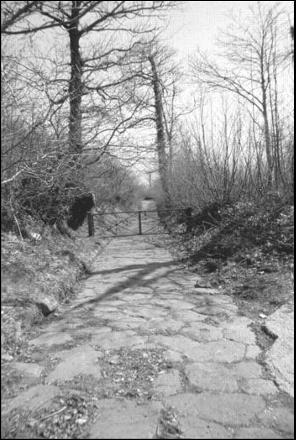The Complete Idiot's Guide to the Roman Empire (31 page)
Read The Complete Idiot's Guide to the Roman Empire Online
Authors: Eric Nelson

 Â
 If They Build It: Roman Engineering
In This Chapter
- How the Romans built to last
- Roman roads and aqueducts
- Urban planning and design
- Military engineering and building
The Romans were expert engineers and practical builders, and it's not hard to appreciate what they left behind. There are cities, buildings, roads, aqueducts, tunnels, and bridges all built to last and many still in use. These remains, however, followed conquests, and conquest depended on less permanent constructions for which the Romans were equally famous: military camps, siege engines, and the machines of war.
Besides being a professor, I've been a builder and a landscaper. From this experience, I've come to appreciate four consistent Roman approaches to enduring creations: do the math, prepare the earth, create a stable foundation, and build to last. I also admire two character traits that present themselves in their best work: practical problem solving and a tenacious determination to do things right. The Romans weren't necessarily fancy or experimental. You can attribute a great deal of Roman success to consistent and skillful application of fundamental techniques they had already learned by the sixth century
B
.
C
.
E
., such as digging ditches, working with stone, and building an arch. Once they found something that worked, they stuck with it.
In this chapter, we'll examine Roman building and engineering in civic and military areas.
Roman building depended on concrete, which they began working with about 300
B
.
C
.
E
. The Romans made two important contributions to concrete. First, they discovered that if they used hard volcanic sand from Mt. Vesuvius (
pulvis Puteolanus
) in the mix, the concrete became hard enough to withstand nearly any weathering, including immersion in flowing rivers. Concrete mixes today use super-hard particles (such as silica) to achieve similar durability. Second, the Romans refined their knowledge of mixing (using additives such as animal fat to manipulate cement properties), pouring, and curing concrete, and understood its properties even if they didn't understand its chemistry. With this knowledge, they could work concrete in dry and wet (including underwater) conditions.
Besides cranes, carts, shovels, and stone working tools, it doesn't take many tools to do good excavation and concrete work. Romans used a sighting instrument, called a
diptra,
to measure changes in elevation. To sight right angles, establish a parallel track with other lines, and calculate crossroads, they used an instrument called a
groma.
The
groma
looked like a crossroad sign with plumb lines attached to each end of the street signs. You sighted along either sign to find or establish new points. When establishing level or grade for aqueducts, the Romans used a long wooden table, called a
chorobates
. This table had a rounded, lengthwise groove in the top, which served as a water level.
Â
Great Caesar's Ghost!
It may surprise you to learn that concrete is about as old asâwell, about as old as concrete lasts. The ancient Mesopotamians and Egyptians used it. With apologies to “mud” contractors everywhere for the simplistic recipe, you make concrete by heating limestone until all the water molecules burn off. Pulverize the lime and mix in sand. This makes mortar. Mix mortar with small stone and gravel to get concrete mix. Add water to the dry ingredients, mix thoroughly, and let set. Chemistry takes over and produces (depending on mix and conditions) artificial rock (concrete).
The old proverb “all roads lead to Rome” is really backwards, of course. The Romans began constructing their extensive network of inter-provincial highways
from
the center of their city. Beginning with Gaius Gracchus (see Chapter 7, “Let's Conquer . . . Ourselves! The Roman Revolution and the End of the Republic”), distances were marked in mileposts measured from the
miliarium aureum
(golden milepost), a marker in the Forum. A Roman mile is 1,000 paces, and our word “mile” comes from Roman
mille
(thousand).
The Romans built roads to aid in the quick movement of defensive forces and to facilitate trade and commerce. Beginning with the famous
Via Appia,
successive roads were proposed and built by the censors to allow legions to protect Rome's interests. As Rome's reach grew, so did the length of its roads. The first great roads ran primarily north-south, but because troops were stationed in northern and southern Italy, east-west connecting roads were added, as well as roads in Gaul and Macedonia to facilitate troop movements to these new provinces.
Â
Veto!
The
Via Appia
was not the first road from Rome; Rome was on the crossroads of several trade routes, and road maintenance is mentioned in the Twelve Tables (ca 450
B
.
C
.
E
.). The
Via Salaria
(Salt Road) up to the mountains and the inland route to Capua, the
Via Latina,
were gravel roads built before the
Via Appia.
Some of the major road projects of the Republic were . . .
- Via Appia
(312
B
.
C
.
E
.) from Rome to Terracina and to Capua. - Via Aemilia
(241
B
.
C
.
E
.) from Rome to Piza along the coast. - Via Flaminia
(220
B
.
C
.
E
.) from Rome to Rimini (Ariminum). - Via Valeria
(210
B
.
C
.
E
.) in Sicily. - Via Aemelia
(187
B
.
C
.
E
.) connecting (east-west) Rimini to Piacenza through Balogna. - Via Cassia
(177
B
.
C
.
E
.) from Rome to Arezzo; reaching Florence and Pisa in 125
B
.
C
.
E
. - Via Postumia
(148
B
.
C
.
E
.) connecting Benoa, Piacenza, Cremona, Aquileia;
Via Aemilia
extends to Piacenza and Tortona. - Via Egnatia
(146
B
.
C
.
E
.) from the Balkans to Greece; from Dyrrachium (Durazzo) to Thessolonica. - Via Domitia
(118
B
.
C
.
E
.) in Gaul Narbonnensis from the Rhone River to the Pyrranees. - Via Emilia Scauri
(109
B
.
C
.
E
.) extends
Via Aurelia. - A road from Turin to Vienne (in France) over the little St. Bernard Pass built by Pompey the Great (77
B
.
C
.
E
.). - Julius Caesar's improvement to the route over the Great St. Bernard Pass (57
B
.
C
.
E
.).
Â
Great Caesar's Ghost!
The primary reason for building Rome's major roads and its interstate highway system was military, not commercial.
Still miles to go: a Roman road.

After a road was proposed, the censor figured the cost of the project, and bidding went out to the
publicani
(private companies). The road course was carefully laid out. Routes ran straight from one sighting point to the next (you didn't need banked or gentle curves for fast-moving traffic) or followed along natural topography.
Once the route was established, a roadbed (about 15 feet wide) was cut into the soil about 2 to 3 feet, and drainage ditches were added along the sides. A good bed was essential for the road to be strong enough to carry legions and huge transport carts (the ancient equivalent to the 16-wheeler) year around, day in and day out. In some wetter areas, this bed had to be built up to a firm platform, called an
agger
(we call this a “highway”). Drainage problems were then addressed (not only are wet roadbeds unstable and mucky, but they tend to buckle and shift when they freeze). Cisterns, for example, might be added to help shunt away road runoff.
A foundation of rock and gravel road ballast was laid down and compacted, and often a layer of sand or other impact-absorbing material was put on top of that. The final metalling surface had to remain stable and hard, and its composition depended upon its use, costs, and local materials available. Many roads were metalled with gravel or flint, and were paved only near the cities where traffic was heaviest. Near iron mines, the slag and mining tailings were used, which rusted together to create a hard surface. In Africa, the Romans discovered that a sloped dirt roadway became hard as rock and needed no
metalling.
The most durable (and recognizable) metalling was multisided random stones, laid without mortar and cut individually to fit firmly against each other. (Appius Claudius the Blind was said to have examined the joint workmanship with his bare feet.) Fine sand and gravel was added around and over the top to sift into the cracks. It's not much different than what you do to build a patio of bricks or interlocking “pavers”âonly the first Roman patio was 130 miles long!
Â
When in Rome
Metalling
does not refer to “metal” (as in iron or bronze) in this context, but to the top surface of the road (such as the pavement), which bears the wear and tear of use and weather.
The major Roman roads were called
viae publicae,
public highways, and funded by public funds.
Viae militares
were funded by the military. Local byways (
actus
) and private roads (
viae privatae
) were built to connect with public roads. Maintenance of public roads was highly organized and consistent; maintenance of local and private roads was the concern of those who needed and constructed them.
Â
Roamin' the Romans
The keystone arch was the Romans' primary load-bearing architectural form. The keystone, which was shaped like a “V,” was set at the top of an arch, banded, and cemented into place. Arches could be constructed of stone, brick, or concrete. Practical, strong, and beautiful, arches appear in all kinds of Roman construction, from aqueducts to basilicas and the Colosseum.
Â
Lend Me Your Ears
Gaius Julius Lacer had this inscription placed on his tomb, which overlooks the bridge at Alcantara in Spain, his masterpiece:Pontem perfeci mansurum in saecula:
“I have completed a bridge that will endure into the ages.”
And so it has.
